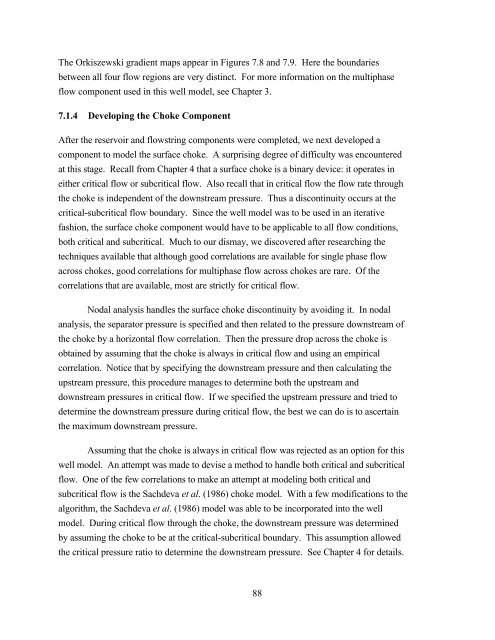multivariate production systems optimization - Stanford University
multivariate production systems optimization - Stanford University
multivariate production systems optimization - Stanford University
Create successful ePaper yourself
Turn your PDF publications into a flip-book with our unique Google optimized e-Paper software.
The Orkiszewski gradient maps appear in Figures 7.8 and 7.9. Here the boundaries<br />
between all four flow regions are very distinct. For more information on the multiphase<br />
flow component used in this well model, see Chapter 3.<br />
7.1.4 Developing the Choke Component<br />
After the reservoir and flowstring components were completed, we next developed a<br />
component to model the surface choke. A surprising degree of difficulty was encountered<br />
at this stage. Recall from Chapter 4 that a surface choke is a binary device: it operates in<br />
either critical flow or subcritical flow. Also recall that in critical flow the flow rate through<br />
the choke is independent of the downstream pressure. Thus a discontinuity occurs at the<br />
critical-subcritical flow boundary. Since the well model was to be used in an iterative<br />
fashion, the surface choke component would have to be applicable to all flow conditions,<br />
both critical and subcritical. Much to our dismay, we discovered after researching the<br />
techniques available that although good correlations are available for single phase flow<br />
across chokes, good correlations for multiphase flow across chokes are rare. Of the<br />
correlations that are available, most are strictly for critical flow.<br />
Nodal analysis handles the surface choke discontinuity by avoiding it. In nodal<br />
analysis, the separator pressure is specified and then related to the pressure downstream of<br />
the choke by a horizontal flow correlation. Then the pressure drop across the choke is<br />
obtained by assuming that the choke is always in critical flow and using an empirical<br />
correlation. Notice that by specifying the downstream pressure and then calculating the<br />
upstream pressure, this procedure manages to determine both the upstream and<br />
downstream pressures in critical flow. If we specified the upstream pressure and tried to<br />
determine the downstream pressure during critical flow, the best we can do is to ascertain<br />
the maximum downstream pressure.<br />
Assuming that the choke is always in critical flow was rejected as an option for this<br />
well model. An attempt was made to devise a method to handle both critical and subcritical<br />
flow. One of the few correlations to make an attempt at modeling both critical and<br />
subcritical flow is the Sachdeva et al. (1986) choke model. With a few modifications to the<br />
algorithm, the Sachdeva et al. (1986) model was able to be incorporated into the well<br />
model. During critical flow through the choke, the downstream pressure was determined<br />
by assuming the choke to be at the critical-subcritical boundary. This assumption allowed<br />
the critical pressure ratio to determine the downstream pressure. See Chapter 4 for details.<br />
88

















